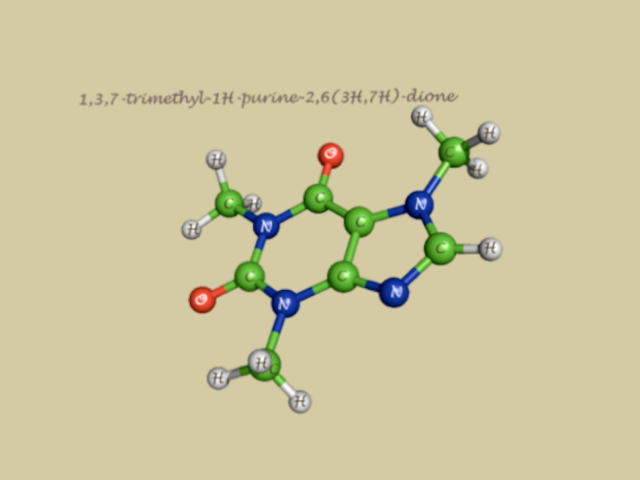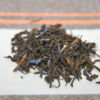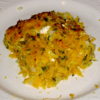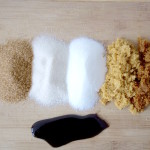
Yes when I start with a topic I continue until I exhausts it. That s what I am doing with coffee. Not really I just always wanted to know how coffee effects humans. It is different from human to human and I always wanted to know the source of this deviation. Well as you probably most know the major reason is the molecule of 1,3,7-trimethyl-1H-purine-2,6(3H,7H)-dione, or also known as caffeine. The chemical formula is C8H10N4O2 or and the molecular weight is 194.19 g/mol. So what is so important about caffeine? Why consumption can be so drastic on us.
Caffeine can be absorbed by the human digestive system in 45 min to an hour. However the half-life of caffeine — the time required for the body to eliminate one-half of the total amount of caffeine consumed at a given time — varies widely among individuals according to such factors as age, liver function, pregnancy, some concurrent medications, and the level of enzymes in the liver needed for caffeine metabolism. In healthy adults, caffeine’s half-life is approximately 3-4 hours. During the metabolizing cycle caffeine transofor to three different compounds, Paraxanthine, Theobromine and Theophylline.
- Paraxanthine (84%) – Has the effect of increasing lipolysis, leading to elevated glycerol and free fatty acid levels in the blood plasma.
- Theobromine (12%) – Dilates blood vessels and increases urine volume. Theobromine is also the principal alkaloid in cocoa, and therefore chocolate.
- Theophylline (4%) – Relaxes smooth muscles of the bronchi, and is used to treat asthma. The therapeutic dose of theophylline, however, is many times greater than the levels attained from caffeine metabolism.
Although the above compounds are not directly related to the immediate effect of caffeine they can intensify by increasing the release of hormones like epinephrine. Like alcohol, nicotine, and antidepressants, caffeine readily crosses the blood brain barrier. Once in the brain, the principal mode of action of caffeine is as an antagonist of adenosine receptors found in the brain. The caffeine molecule is structurally similar to adenosine, and binds to adenosine receptors on the surface of cells without activating them (an “antagonist” mechanism of action). Adenosine is a molecule consisting of a nucleoside comprised of adenine attached to a ribose (ribofuranose) moiety. The primary function of adenosine is to suppress fast rhythms of the heart (cardiac arrhythmias) and has similar effects to the other cells. The part of the adenosine that binds of the surface of the brain cells is the adenine that is very similar to the caffeine. Upon caffeine intake the caffeine molecules will bind on the surface of the brain cells, without causing any effects, but blocking the sites where the adenine would normally adsorb. And although the adenosine usually adsorbed by the cells in mater of seconds freeing therefore the adsorption sites, caffeine can remain adsorbed for longer period that can last up to 3-4 hours occupying the adsorption sites for 3-4 hours.
Therefore, caffeine acts as a competitive inhibitor. The reduction in adenosine activity results in increased activity of the neurotransmitter dopamine, largely accounting for the stimulatory effects of caffeine. Caffeine can also increase levels of epinephrine/adrenaline, possibly via a different mechanism. Acute usage of caffeine also increases levels of serotonin, causing positive changes in mood.
 However the increased in activity of the brain and nerve system is not accommodated by a similar increase in the quality of the work. While relatively safe for humans, caffeine is considerably more toxic to some other animals such as dogs, horses and parrots due to a much poorer ability to metabolize this compound. Caffeine has a much more significant effect on spiders, for example, than most other drugs do. In the figure on the right a very interesting experiment. The image on the top right is a spider that is caffeine free, while at the right bottom figure the spider is high on caffeine.
However the increased in activity of the brain and nerve system is not accommodated by a similar increase in the quality of the work. While relatively safe for humans, caffeine is considerably more toxic to some other animals such as dogs, horses and parrots due to a much poorer ability to metabolize this compound. Caffeine has a much more significant effect on spiders, for example, than most other drugs do. In the figure on the right a very interesting experiment. The image on the top right is a spider that is caffeine free, while at the right bottom figure the spider is high on caffeine.The difference to the response of different animals and actually among humans is the different amount of adenosine the brain and nerve cells need. In humans has also to do with the metabolic reactions and the time they require to happen. Once caffeine is broken to paraxanthine, theobromine and theophylline practically it stops working.
One other minor but important side effect of caffeine, is that theobromine is causing frequent urination, and therefore you may run onto the risk of dehydration. So get coffee with moderation. If you think that the effect is too strong on you add milk. The fat of the milk will bind on the caffeine, which is a hydrophobic nature molecule and will slow down the release in the blood stream.












Leave a Reply